Sticky rice, a beloved staple in Thai and Lao cuisine, holds a special place in Southeast Asian culinary traditions. At SIXT.VN, we understand the importance of experiencing authentic flavors, and we’re here to guide you through the traditional method of preparing this delightful dish. Discover the cultural significance and learn how to perfectly steam sticky rice, also known as glutinous rice, using traditional wooden containers, unlocking a truly immersive gastronomic adventure when traveling to Vietnam or neighboring countries. This cooking method is perfect for preparing a Northern Thai staple and sticky rice dishes that you can find throughout Southeast Asia.
1. What Exactly Is Sticky Rice?
Sticky rice, known as khao neow (ข้าวเหนียว) in Thai, which translates directly to “sticky rice”, is a unique variety of rice prized for its glutinous texture. It is a versatile ingredient in Southeast Asian cuisine.
When cooked, the grains cling together, making it ideal for eating with your fingers – a common practice in Thailand and Laos. This stickiness comes from its composition: sticky rice contains very little amylose and is primarily composed of amylopectin, a starch component responsible for its characteristic texture, according to The Kitchn. Unlike regular long-grain rice, raw sticky rice appears whiter and more opaque. Considered a substantial source of energy, it’s a staple food, especially among farmers and laborers, providing lasting sustenance, as noted by Huffington Post.
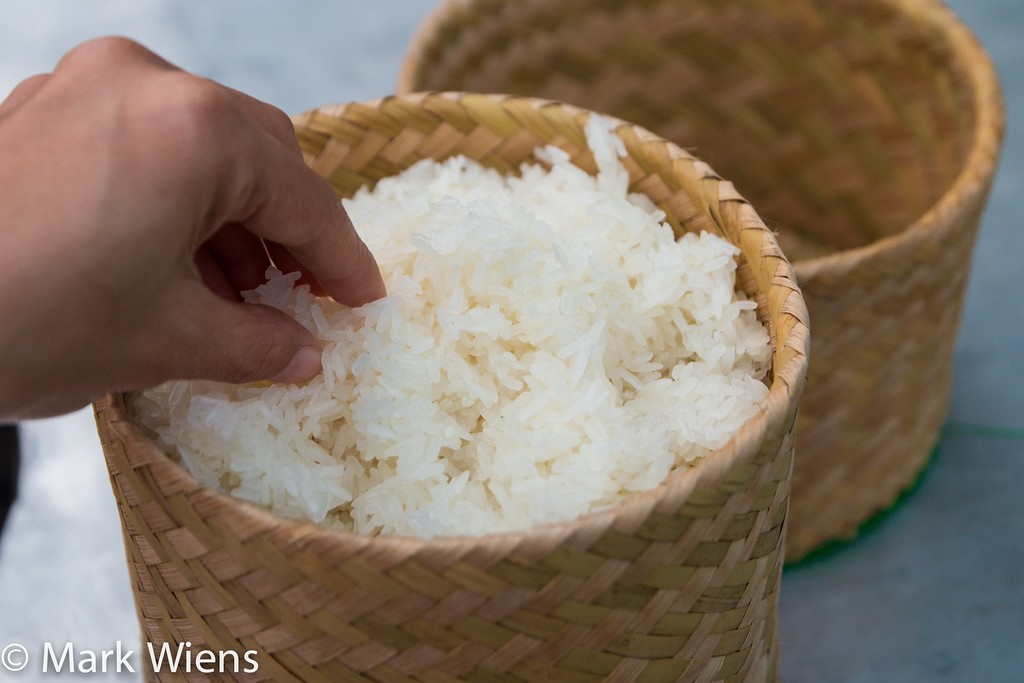 Close-up of uncooked sticky rice grains
Close-up of uncooked sticky rice grains
2. Where Is Sticky Rice a Staple Food?
Sticky rice is mainly eaten in Northeast and Northern Thailand, and Laos. These regions share similar cultures and cuisines.
Throughout Isaan (northeastern Thailand) and northern Thailand, sticky rice is a daily staple. You can find it served at every meal – breakfast, lunch, and dinner – and as a snack. Even in bustling Bangkok, sticky rice is widely available due to the large population of people who have migrated from these regions. However, in central and southern Thailand, regular steamed rice is more common, although sticky rice is still enjoyed in desserts. If you’re planning a trip to Thailand, SIXT.VN can help you arrange transportation and accommodations, ensuring you get to experience the best of the local culinary scene.
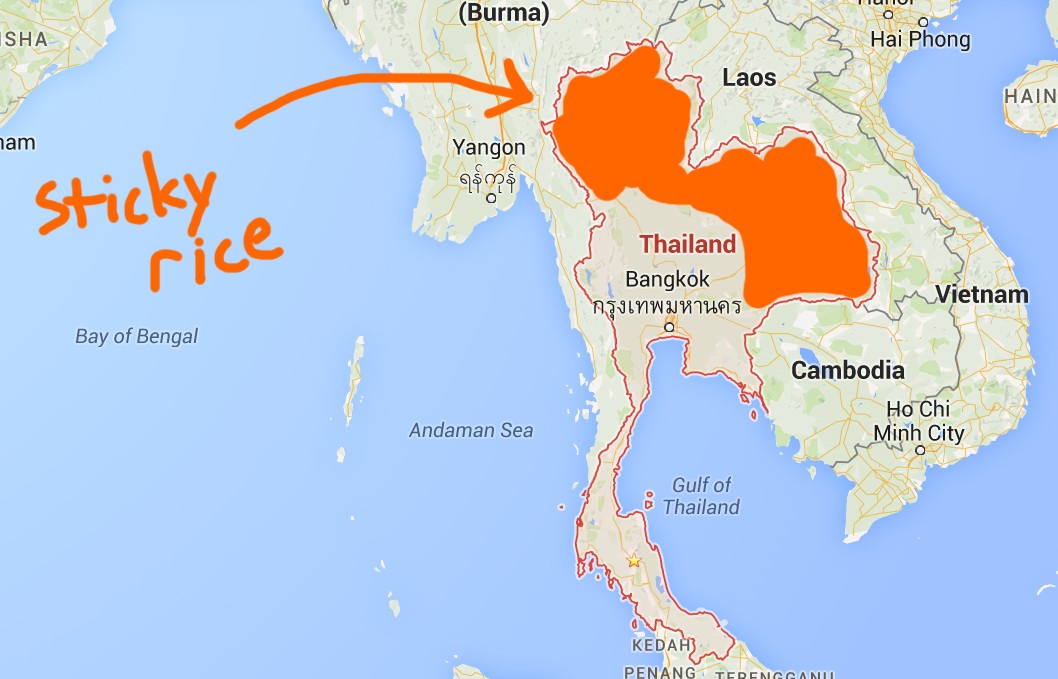 Map highlighting the sticky rice region of Thailand
Map highlighting the sticky rice region of Thailand
3. What Is the Cultural Significance of Sticky Rice?
Sticky rice is more than just a food in Thailand; it’s a cultural cornerstone with a history spanning over 4,000 years in Southeast Asia, according to the Smithsonian. It is deeply intertwined with family and community life.
In traditional Thai households, especially in rural areas, families often live together, sharing meals. Sticky rice is typically prepared in the early morning and kept in a special bamboo basket called a kradib khao neow (กระติ๊บข้าวเหนียว). This communal basket is placed in the center of the table during meals, and everyone takes a portion to eat with various side dishes. Eating with fingers is the norm – small balls of sticky rice are formed and dipped into flavorful sauces, enhancing the overall dining experience. Let SIXT.VN assist you in planning a culturally immersive trip to Thailand, where you can witness and participate in these time-honored traditions firsthand.
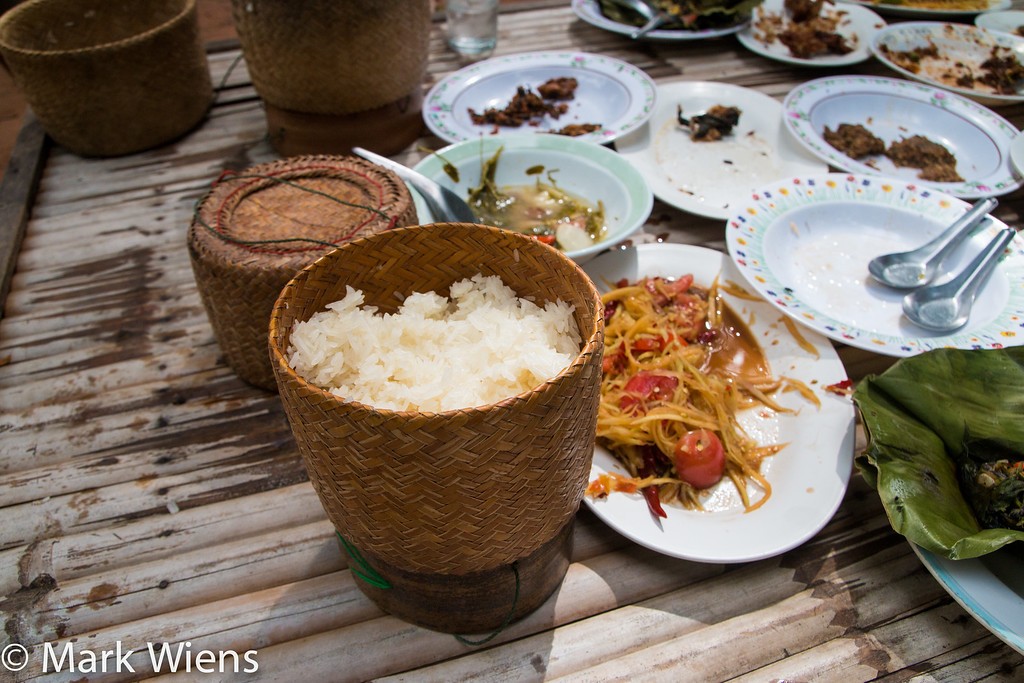 Sticky rice served in a traditional bamboo basket
Sticky rice served in a traditional bamboo basket
4. What Dishes Pair Well With Sticky Rice?
Sticky rice isn’t eaten with every Thai dish; it depends on the region. It goes well with food from Northern and Northeastern Thailand.
Excellent Pairings:
- Isaan and Northern Thai Cuisine: Sticky rice is the ideal accompaniment to the bold and flavorful dishes from these regions.
- Green Papaya Salad (Som Tam ส้มตำ): The spiciness and tanginess of som tam are perfectly balanced by the subtle sweetness of sticky rice.
- Meat Salads (Koi Khua Neua ก้อยคั่วเนื้อ, Laab ลาบ): These savory and often spicy meat salads are traditionally enjoyed with sticky rice.
- Grilled Meats: Whether it’s grilled fish, pork, or aeb (grilled meat in banana leaf), sticky rice complements the smoky flavors beautifully.
Dishes Not Typically Paired:
- Stir-Fried Dishes (Pad Kra Pao): These are usually eaten with regular steamed rice.
- Coconut Milk-Based Curries: Green curry is usually eaten with jasmine rice.
- Soups (Tom Yum, Tom Kha): These are best enjoyed with regular rice.
While personal preferences vary, understanding these traditional pairings will enhance your culinary experience in Thailand. SIXT.VN can provide you with local insights and recommendations to make the most of your gastronomic adventures.
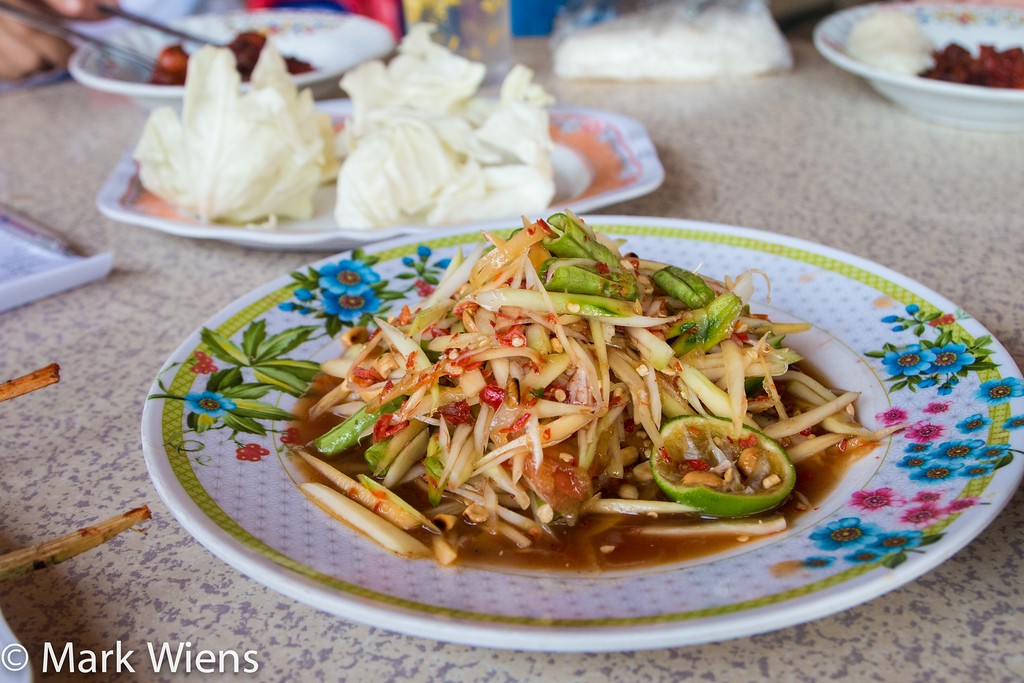 Green papaya salad (som tam) served with sticky rice
Green papaya salad (som tam) served with sticky rice
5. How Is Sticky Rice Typically Cooked in Wooden Containers?
The traditional method of cooking sticky rice involves soaking the rice overnight and then steaming it in a bamboo basket over a pot of boiling water. This method is traditional in Thailand and Laos.
This process ensures that the rice cooks evenly and develops its characteristic sticky texture. While modern methods exist, this traditional approach remains the gold standard for achieving the best results.
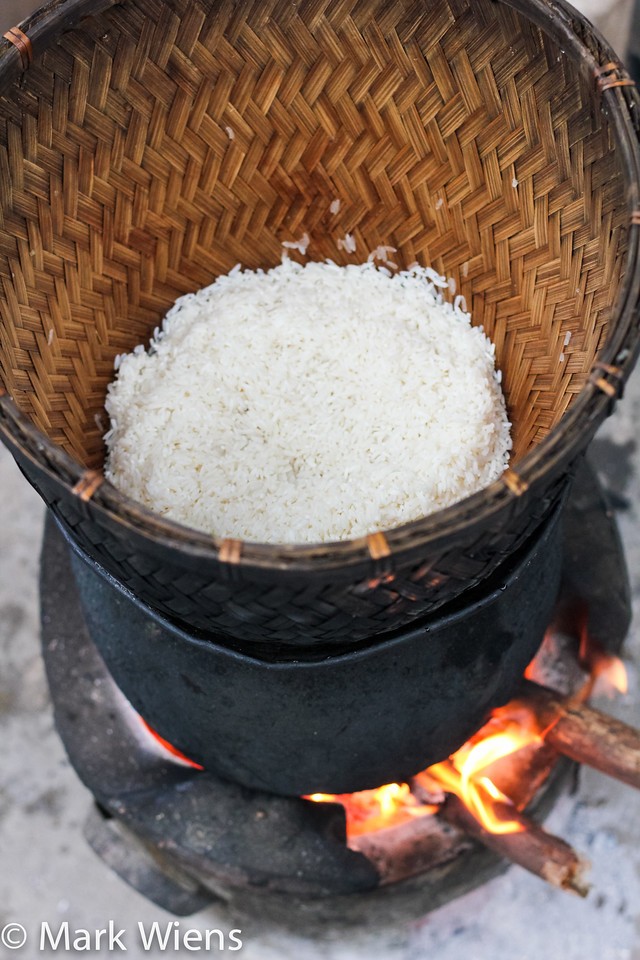 Steaming sticky rice in a bamboo basket
Steaming sticky rice in a bamboo basket
6. What Are the Steps to Cook Sticky Rice Using the Traditional Method?
Here’s how to prepare perfect sticky rice using the traditional method:
-
Soaking:
- Place the sticky rice in a bowl or container.
- Submerge the rice in water, ensuring it’s fully covered.
- Let it soak at room temperature overnight (or for at least 4-5 hours). This step is crucial for achieving the right texture.
-
Steaming:
- After soaking, the grains should be softer and slightly swollen.
- Place the soaked rice into a bamboo steamer basket (teeneung khao neow ที่นึ่งข้าวเหนียว).
- Cover the steamer with a lid or cloth to trap the steam.
- Add water to a pot and place the steamer basket on top, ensuring the water doesn’t touch the rice.
- Bring the water to a boil and steam the rice for 15-20 minutes on medium heat.
-
Checking for Doneness:
- Carefully remove the lid and test the rice for softness and fluffiness.
- If it’s still a bit crunchy, steam for a few more minutes.
- Once cooked, remove from heat and serve immediately or transfer to an airtight container or basket to keep it warm.
-
Serving:
- Serve your perfectly steamed sticky rice hot and fresh with your favorite Isaan or northern Thai dishes.
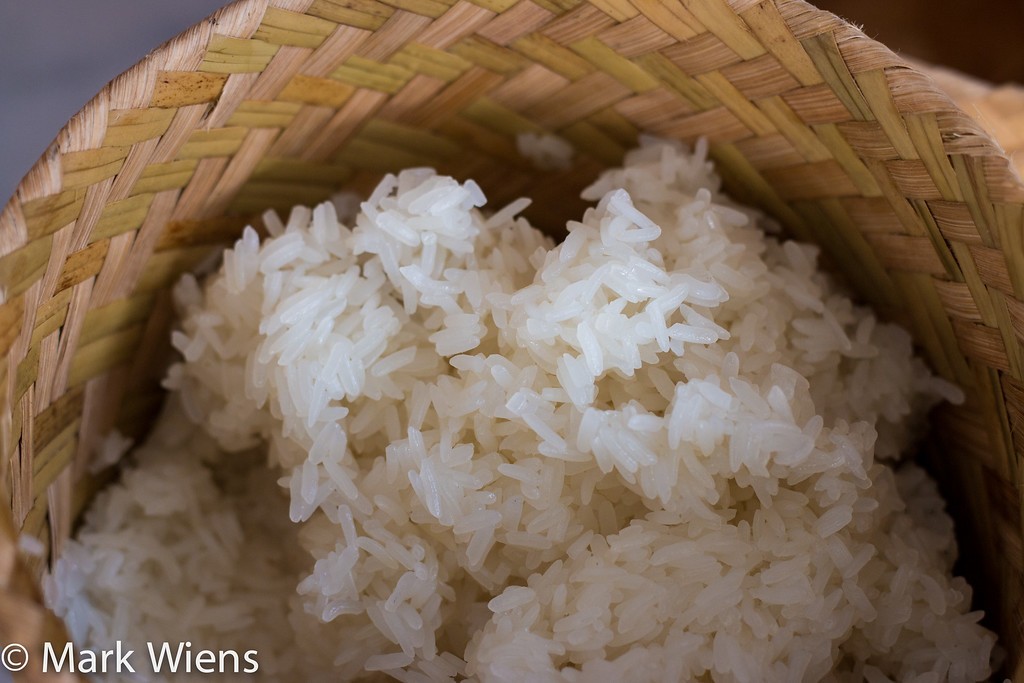 Steps to cook sticky rice
Steps to cook sticky rice
7. What Equipment Do I Need to Cook Sticky Rice Traditionally?
To cook sticky rice using the traditional method, you’ll need:
- Sticky Rice: Also known as glutinous rice. SIXT.VN recommends purchasing high-quality Thai sticky rice for the best results.
- A Large Bowl or Container: For soaking the rice.
- A Bamboo Steamer Basket (teeneung khao neow ที่นึ่งข้าวเหนียว): This is the traditional vessel for steaming sticky rice.
- A Pot: To hold the water for steaming. The steamer basket should fit snugly on top of the pot.
- A Lid or Cloth: To cover the steamer basket and trap the steam.
While alternative steaming methods exist, using a bamboo steamer basket provides the most authentic flavor and texture. If you’re traveling to Thailand and want to purchase these items, SIXT.VN can provide information on local markets and shops.
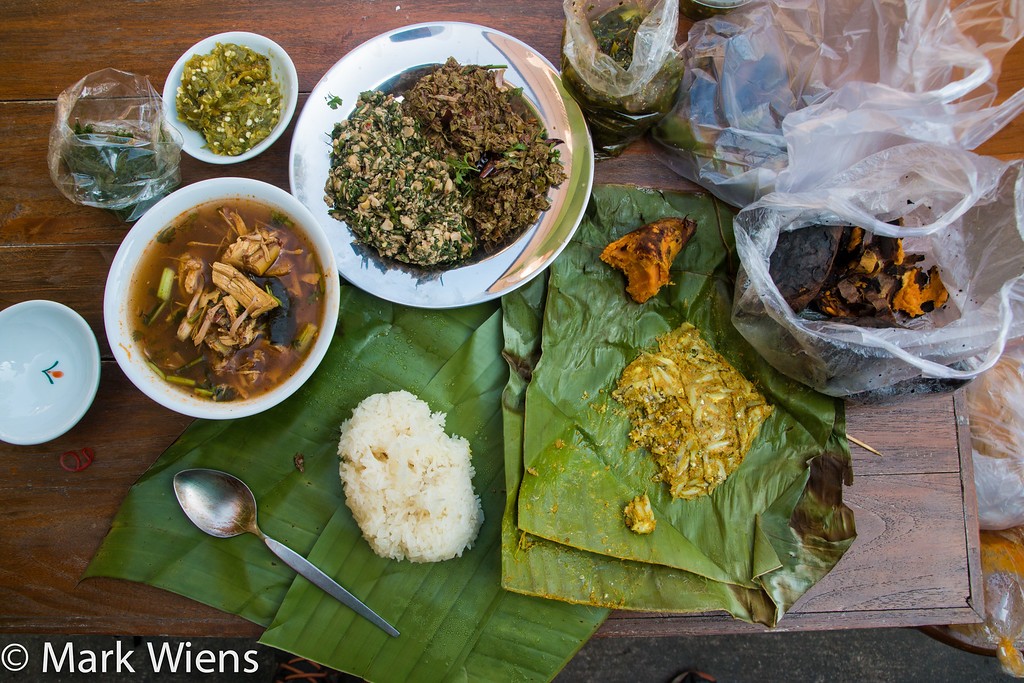 Bamboo steamer basket for cooking sticky rice
Bamboo steamer basket for cooking sticky rice
8. Can I Cook Sticky Rice Without a Bamboo Steamer?
Yes, you can cook sticky rice without a bamboo steamer, though the traditional bamboo steamer is ideal for achieving the best results. A metal steamer is a viable alternative.
Here’s how to do it:
- Prepare the Rice: Soak the sticky rice overnight (or at least 4-5 hours) as you would for the traditional method.
- Set Up Your Steamer: Use a pot with a tight-fitting lid. Place a heat-resistant steaming rack or a metal colander inside the pot, ensuring it sits above the water level.
- Line the Steamer: Line the steaming rack or colander with cheesecloth or a thin, heat-resistant cloth. This will prevent the rice from falling through the holes.
- Add the Rice: Place the soaked and drained sticky rice evenly on the lined steamer.
- Steam the Rice: Add enough water to the pot so that it reaches just below the steamer rack. Bring the water to a boil, then reduce the heat to medium. Cover the pot tightly with the lid.
- Cook the Rice: Steam the rice for about 25-30 minutes, checking periodically to ensure the water hasn’t evaporated. If necessary, add more boiling water to the pot.
- Check for Doneness: After 25-30 minutes, check the rice for doneness. It should be soft, fluffy, and sticky. If it’s still too firm, steam for a few more minutes.
- Serve: Once the rice is cooked, remove it from the steamer and let it sit for a few minutes before serving. This allows any excess moisture to evaporate.
While the flavor might differ slightly from the traditional bamboo steamer method, this alternative still provides a delicious and authentic sticky rice experience.
9. What Are Some Tips for Perfecting Sticky Rice?
Achieving perfect sticky rice requires attention to detail. Here are some essential tips:
- Use High-Quality Rice: Choose authentic Thai sticky rice for the best flavor and texture.
- Soak Adequately: Soaking the rice overnight is crucial for even cooking and the right stickiness. Don’t skip this step!
- Control the Heat: Maintain a consistent medium heat during steaming to ensure the rice cooks evenly without burning.
- Don’t Overcrowd the Steamer: Ensure the rice is spread evenly in the steamer basket to allow for proper steam circulation.
- Check Water Levels: Monitor the water level in the pot during steaming and add more boiling water as needed to prevent it from drying out.
- Rest After Steaming: Allowing the rice to rest for a few minutes after steaming helps to improve its texture.
- Serve Warm: Sticky rice is best enjoyed warm, so serve it immediately after cooking or keep it warm in a covered container.
By following these tips, you’ll be well on your way to creating delicious, authentic sticky rice every time. SIXT.VN can connect you with local cooking classes in Thailand where you can learn these techniques from experienced chefs.
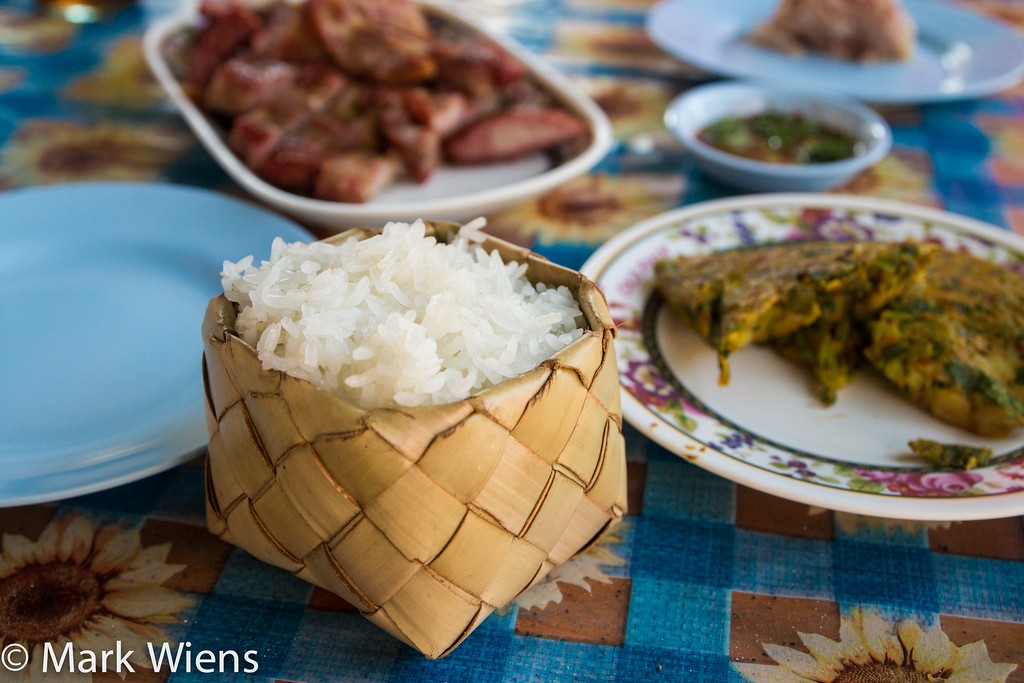 Serving Thai sticky rice
Serving Thai sticky rice
10. What Are the Health Benefits of Sticky Rice?
Sticky rice is more than just a delicious staple; it also offers several health benefits:
- Energy Source: Sticky rice is a great source of carbohydrates, providing sustained energy, making it ideal for those with active lifestyles, as stated by Huffington Post.
- Gluten-Free: Naturally gluten-free, sticky rice is a safe and delicious option for those with gluten sensitivities or celiac disease, according to The Kitchn.
- Rich in Nutrients: It contains essential nutrients like iron, niacin, and thiamin, contributing to overall health and well-being.
- Easy to Digest: Sticky rice is generally easy to digest, making it a good choice for those with sensitive stomachs.
While sticky rice offers these benefits, it’s important to consume it in moderation as part of a balanced diet.
11. How Can SIXT.VN Enhance My Culinary Experience in Vietnam and Thailand?
SIXT.VN is your ideal partner for planning a culinary adventure in Vietnam and Thailand, where you can fully immerse yourself in the culture of sticky rice.
We offer:
- Customized Itineraries: We can create personalized travel plans that include visits to local markets, cooking classes, and restaurants specializing in authentic sticky rice dishes.
- Transportation: Enjoy seamless travel with our reliable airport transfer services and car rental options, allowing you to explore the region at your own pace. Address: 260 Cau Giay, Hanoi, Vietnam.
- Accommodation: We partner with a wide range of hotels to suit your budget and preferences, ensuring a comfortable and convenient stay.
- Tours and Activities: Discover hidden culinary gems with our guided tours and cooking demonstrations, led by local experts.
- Local Insights: Benefit from our in-depth knowledge of the region, including recommendations for the best places to sample sticky rice and other local delicacies.
Let SIXT.VN take the stress out of planning your trip, so you can focus on savoring the flavors of Southeast Asia. Contact us today to start planning your culinary adventure Hotline/Whatsapp: +84 986 244 358 or visit our website: SIXT.VN.
12. What Are Some Other Must-Try Thai Dishes?
While sticky rice is a must-try, Thailand’s culinary landscape offers a diverse array of dishes.
Here are a few more to add to your list:
- Tom Yum Soup: A hot and sour soup with fragrant herbs and spices.
- Pad Thai: Stir-fried rice noodles with shrimp, tofu, peanuts, and bean sprouts.
- Green Curry: A creamy coconut milk-based curry with green chilies, vegetables, and meat.
- Mango Sticky Rice: A sweet and creamy dessert featuring sticky rice, fresh mango, and coconut milk.
- Massaman Curry: A rich and flavorful curry with Indian and Malay influences.
Exploring these dishes will provide you with a well-rounded taste of Thai cuisine. SIXT.VN can help you find the best restaurants and street food vendors to sample these delicacies.
13. What Mistakes Should I Avoid When Cooking Sticky Rice?
To ensure your sticky rice turns out perfectly, avoid these common mistakes:
- Skipping the Soaking Step: Soaking is crucial for achieving the right texture.
- Using the Wrong Type of Rice: Make sure you use authentic Thai sticky rice, not regular long-grain rice.
- Adding Too Much Water: Overwatering can result in mushy rice.
- Cooking at Too High a Heat: High heat can cause the rice to burn or cook unevenly.
- Not Checking for Doneness: Check the rice regularly during steaming to ensure it doesn’t overcook or undercook.
- Serving Cold: Sticky rice is best enjoyed warm, so avoid serving it cold.
By being mindful of these potential pitfalls, you can confidently prepare delicious sticky rice every time.
14. How Do I Store Leftover Cooked Sticky Rice?
Proper storage is essential to maintain the quality of leftover cooked sticky rice.
Here’s how to do it:
- Cool the Rice: Allow the rice to cool completely before storing it.
- Transfer to an Airtight Container: Place the cooled rice in an airtight container to prevent it from drying out.
- Refrigerate: Store the container in the refrigerator for up to 2-3 days.
- Reheat: To reheat, add a tablespoon of water to the rice and microwave for 1-2 minutes, or steam it for a few minutes until heated through.
Properly stored sticky rice will retain its flavor and texture for several days, allowing you to enjoy it at your convenience.
15. Can I Freeze Cooked Sticky Rice?
Yes, you can freeze cooked sticky rice for longer storage.
Here’s how:
- Cool the Rice: Allow the rice to cool completely.
- Portion and Wrap: Divide the rice into individual portions and wrap each portion tightly in plastic wrap.
- Freeze: Place the wrapped portions in a freezer-safe bag or container and freeze for up to 2-3 months.
- Reheat: To reheat, thaw the rice in the refrigerator overnight. Then, add a tablespoon of water and microwave for 1-2 minutes, or steam it for a few minutes until heated through.
Freezing is a great way to preserve sticky rice for future meals.
FAQ About Cooking Sticky Rice (Steamed in Wooden Containers)
1. What is the difference between sticky rice and regular rice?
Sticky rice, also known as glutinous rice, has a higher amylopectin content, making it sticky when cooked, while regular rice has a lower amylopectin content and is less sticky.
2. Why is it important to soak sticky rice before cooking?
Soaking sticky rice allows it to absorb water, which helps it cook evenly and achieve its characteristic sticky texture.
3. Can I use a rice cooker to cook sticky rice?
Yes, but for the most authentic results, steaming in a bamboo basket is recommended. A rice cooker can be used as a substitute if a steamer is not available.
4. How do I know when sticky rice is cooked properly?
Cooked sticky rice should be soft, fluffy, and sticky. Taste-test to ensure it’s not too firm or crunchy.
5. What is the best way to keep sticky rice warm after cooking?
Store cooked sticky rice in an airtight container or a traditional bamboo basket to keep it warm and prevent it from drying out.
6. Is sticky rice healthy?
Sticky rice provides energy and nutrients like iron and niacin, but it should be consumed in moderation as part of a balanced diet.
7. Can I add flavor to sticky rice while cooking?
Yes, you can add a pinch of salt or a splash of coconut milk to the rice before steaming for added flavor.
8. What are some popular dishes that use sticky rice?
Popular dishes include mango sticky rice, sticky rice with grilled pork, and sticky rice served with green papaya salad (som tam).
9. Where can I find authentic Thai sticky rice?
You can find Thai sticky rice at Asian markets, specialty food stores, and online retailers. SIXT.VN can point you to local markets during your visit.
10. Can I make sticky rice in a microwave?
While not traditional, you can microwave sticky rice. Place soaked rice in a microwave-safe bowl with a little water, cover, and microwave in intervals, checking for doneness.



